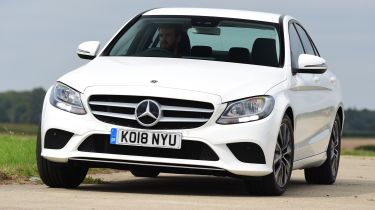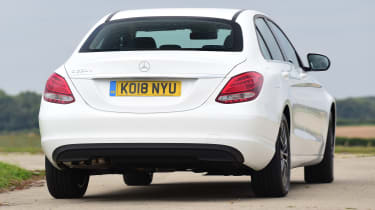Used Mercedes C-Class (Mk4, 2014-2021) - What's it like to drive?
The Mk4 Mercedes C-Class remains a solid, stable cruiser, while AMG offerings are still huge fun
The Mercedes C-Class is a car that focuses more on comfort and handling, and is more suited to life on long motorway cruises than on a twisty road. While there are more sporting and fun to drive alternatives out there, the C-Class Mk4 is still a decent-enough steer, and the high-performance AMG models in particular are great fun.
Engines and performance
Finding the ideal engine for you in a used Mercedes C-Class Mk4 shouldn’t be too difficult, as the car was available with a broad array of options when new. These ranged from more modestly powered petrols and diesels to a pair of punchy engines reserved for the high-performance AMG models and even a selection of plug-in hybrid offerings.
Many of the used C-Class Mk4 examples you’ll come across will likely have diesel engines. The entry-level C200d models are decent options, although the C220d is a more flexible choice if you need a bit more performance or regularly do a bit of towing. If you need more performance still, there were even punchier C250d and C300d diesel options to choose from.
It’s a similar story on the petrol engine front. C180 cars have enough punch if you mostly drive around towns and cities, but performance is more adequate on the mildly more powerful C200 option. If you need more performance still, there was also a punchy C300 engine, though this is more expensive to run.
Used - available now

2015 Mercedes
C Class
63,503 milesAutomaticDiesel2.1L
Cash £12,693
2017 Mercedes
C Class
64,643 milesAutomaticPetrol2.0L
Cash £10,995
2019 Mercedes
C Class
41,392 milesAutomaticDiesel2.0L
Cash £17,000
2019 Mercedes
C Class
17,210 milesAutomaticDiesel2.0L
Cash £17,100Do bear in mind that, even on models sold throughout the C-Class Mk4’s production run, the engine line-up did change. While the C180d diesel used the same 1.6-litre engine, the 2.1-litre four-cylinder that was used on all other pre-facelift diesel models was replaced with a more refined 2.0-litre four-cylinder as part of the facelift in 2018. For the petrol engines, the C200’s original 2.0-litre four-cylinder was replaced in the facelift with a 1.5-litre four-cylinder, with the rest of the range (bar the 3.0-litre six-cylinder C43 and 4.0-litre V8 C63 AMG models) using variations of a 2.0-litre four-cylinder.
Also be wary that the gearbox choices changed during the facelifts, too. Originally, the C-Class Mk4 was available with either a six-speed manual or a seven-speed automatic, with many of the engines being automatic-only. After the 2018 facelift, the manual gearbox was dropped entirely and the seven-speed automatic was replaced with a nine-speed automatic gearbox.
Over the course of the C-Class Mk4’s lifecycle, a pair of plug-in hybrid engines were also available, in the form of the 320hp C300e petrol-electric and 306hp C300de diesel-electric setups. On paper, they promise great efficiency (Mercedes claims the C300e and C300de can return up to 188mpg and 235mpg respectively), but how close you’ll get to that in day-to-day driving will depend on how often you can make use of their electric-only ranges of up to 35 miles. They were also very expensive when new, so aren’t as common as petrol and diesel C-Class Mk4s in the classifieds.
On the road
The Mercedes C-Class Mk4 is a car that focuses more on comfort than driving thrills, which means it’s worth considering if you do lots of long journeys. Regardless of whether the car’s using the regular suspension or the optional air suspension system, the C-Class has a pleasantly pliant ride, which in conjunction with the good noise insulation makes the Mercedes a well-rounded motorway cruiser.
Because of that focus on comfort, the C-Class Mk4 isn’t as precise or as fun to drive as some other executive saloons, such as the BMW 3 Series and Jaguar XE. That said, the car does feel fairly agile relative to its size thanks to the direct steering. However, unless you go for one of the high-performance AMG models, the front tyres do start to lose grip a bit sooner than we’d like when you’re going around corners.
For a majority of Mercedes C-Class models, the car came as standard with rear-wheel drive. If you need a bit more traction for towing duties or extra peace of mind when driving in slippery conditions, an optional all-wheel-drive setup was available on the C200 petrol and C220d and C300d diesel models. Both the C43 and C63 AMG versions of the Mercedes C-Class were only available with all-wheel drive.








